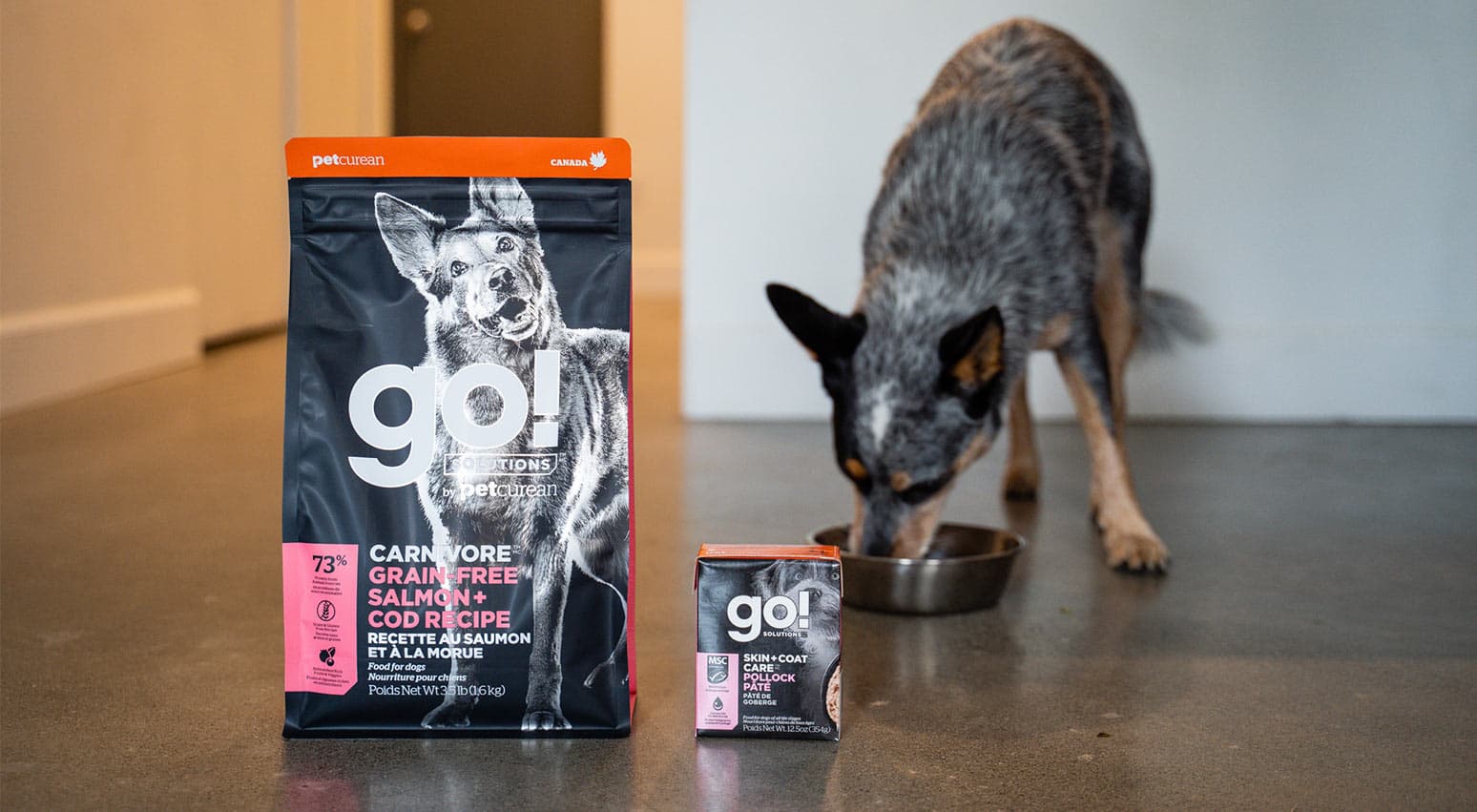The Blue Heeler, also known as the Australian Cattle Dog, is a breed renowned for its intelligence, loyalty, and boundless energy. Whether they’re herding cattle or simply serving as your faithful companion, Blue Heelers require a balanced and nutritious diet to support their active lifestyle. In this article, we will explore the best dog food options for Blue Heelers, taking into account their unique nutritional needs and preferences.
Blue Heeler’s Nutritional Needs
Blue Heelers are medium-sized dogs with a lean build and incredible stamina. To keep up with their active lifestyles, they need a well-rounded diet that provides the following essential nutrients:
Protein: Blue Heelers are highly active dogs, and protein is crucial for muscle maintenance and growth. Look for dog foods with high-quality animal proteins, such as chicken, beef, or fish.
Fat: These dogs have plenty of energy to burn, so a moderate amount of healthy fats is important for sustained energy. Omega-3 fatty acids also support skin and coat health.
Carbohydrates: Complex carbohydrates like whole grains, sweet potatoes, and vegetables are a good source of energy for Blue Heelers. They also provide fiber for digestive health.
Vitamins and Minerals: Blue Heelers require a range of vitamins and minerals to maintain overall health. Calcium and phosphorus are vital for strong bones, while vitamins like A, C, and E boost the immune system.
Avoid Fillers: It’s essential to avoid dog foods that contain fillers like corn, soy, and wheat, as Blue Heelers may have sensitivities or allergies to these ingredients.
Portion Control: These dogs can be prone to obesity if overfed. Be sure to feed them according to their size, age, and activity level.
Best Dog Food Options for Blue Heelers
Recommended for Adult Blue Heelers
1. Diamond Naturals Extreme Athlete Formula Dry Dog Food

This high-protein formula is an excellent choice for active Blue Heelers. It provides the energy and nutrients needed to support their vigorous lifestyle. Its balanced ingredients, including real meat, help maintain muscle health. However, it’s essential to monitor portions to prevent overfeeding, given the Blue Heeler’s tendency to gain weight if not properly exercised.
Ingredients: Chicken meal, chicken, ground white rice, peas, cracked pearled barley.
Pros
- 91% of the protein comes from chicken and eggs
- Has probiotics for gut health
- No artificial ingredients
- Easy to digest
Cons
- Some dogs are allergic to chicken
2. Blue Buffalo Wilderness High Protein, Natural Adult Dry Food

Blue Buffalo is known for its quality ingredients, and this formula is no exception. It offers a high protein content and contains essential fatty acids for a healthy coat. This choice is ideal for Blue Heelers who need to maintain their energy levels and stay active.
Ingredients: Deboned chicken, chicken meal, pea protein, peas, tapioca starch.
Pros
- Chicken is the first ingredient
- Has antioxidants, vitamins, and minerals to support your dog’s immune system
- Uses sweet potatoes and peas in place of grains
- Contain omega 3 and omega 6 to support skin and coat health
Cons
- Legumes are linked to dilated cardiomyopathy( DCM)
- May cause digestive issues in some dogs
3. Purina Pro Dry Dog Food
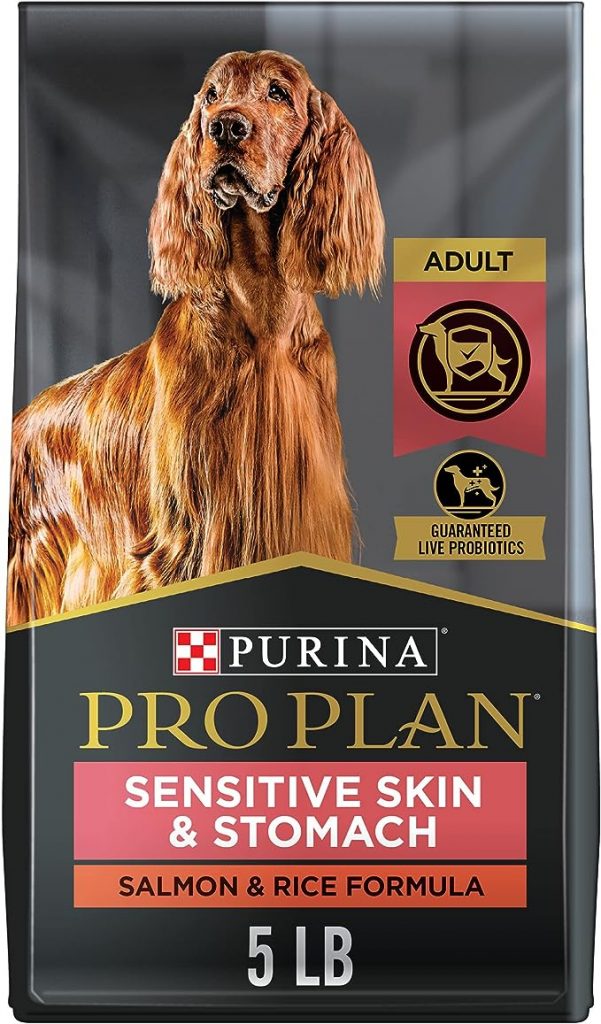
Purina Pro offers a range of options tailored to specific needs. The variety allows you to find the right blend for your Blue Heeler. Ensure that you select a formula that suits your dog’s activity level and dietary preferences.
(Read also: Is Purina Pro Plan A Good Dog Food?)
Ingredients: Chicken, rice, poultry by-product meal, corn gluten meal, whole grain wheat.
Pros
- High in protein
- Easy to digest
Cons
- Has poultry by-product meal
4. Iams Proactive Dry Dog Food
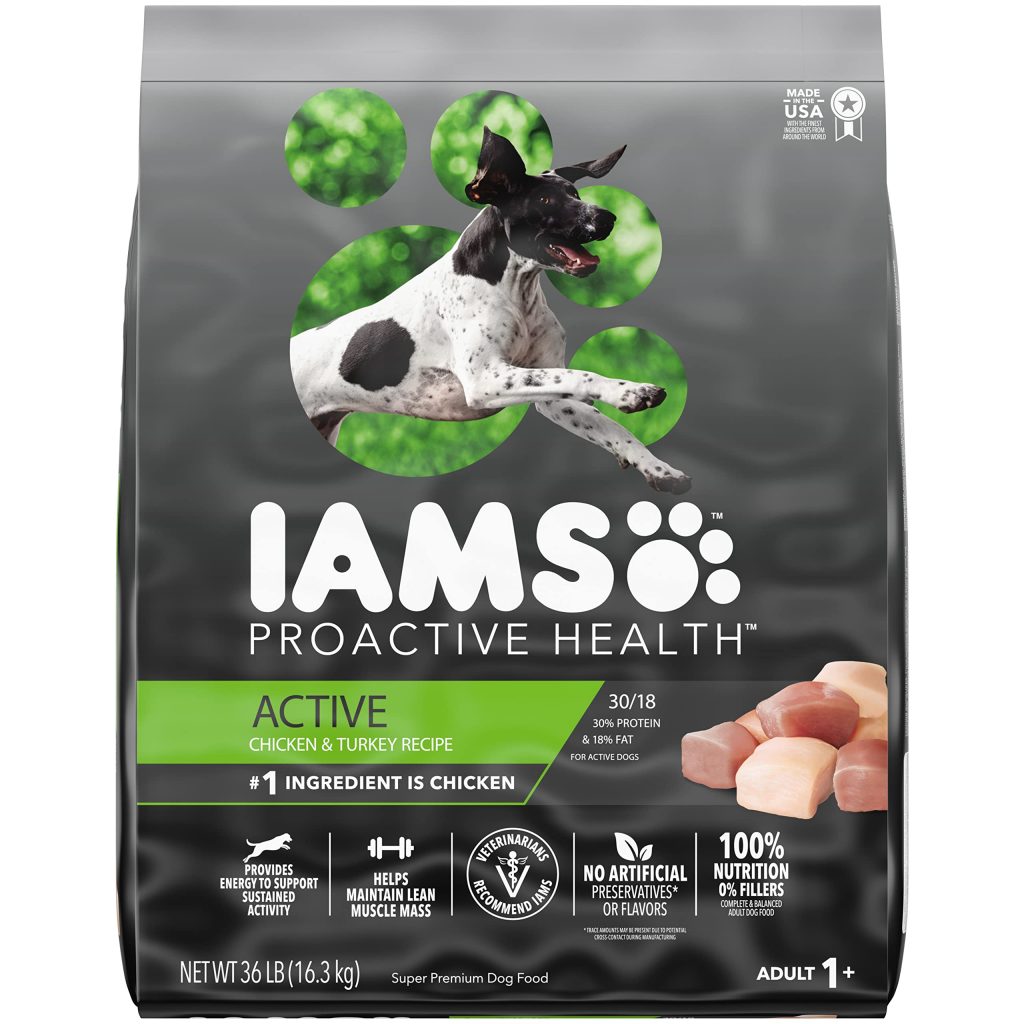
Iams Proactive offers a balanced diet with real chicken as the primary protein source. It contains a range of essential nutrients for overall health and well-being. This option is suitable for Blue Heelers with moderate activity levels.
(Read our IAMS dog food assessment: Is IAMS A Good Dog Food?)
Ingredients: Chicken, corn meal, ground whole grain sorghum, chicken by-product meal, dried beet pulp.
Pros
- High protein content
- Free from artificial preservatives
Cons
- Has chicken by-product
- Hard to digest
- Lacks joint support supplements
Recommended for Blue Healer Puppies
5. ORIJEN Amazing grains puppy dry dog food

ORIJEN is renowned for its biologically appropriate diets, and this puppy formula is no exception. It features high-quality ingredients and a variety of protein sources, making it an excellent choice for developing Blue Heeler puppies.
Ingredients: Deboned chicken, chicken meal, chicken liver, herring meal, turkey meal.
Pros
- High in protein and good fats
- 85% meat
- Free from processed meat, artificial flavors, and preservatives
Cons
- Takes longer for puppies to switch to this formula
- Difficult to digest
- Not suitable for overweight puppies
6. Merrick Backcountry freeze-dried raw puppy recipe

This unique formula combines kibble with freeze-dried raw bits, providing a balanced diet rich in protein and nutrients. It’s a great option for blue heeler puppies that require a higher protein intake.
Ingredients: Deboned chicken, chicken meal, peas, turkey meal, sweet potatoes.
Pros
- Dogs love the taste combo
- Contain omega fatty acid that protects dogs’ skin and coat
- High glucosamine and chondroitin for maintaining healthy hips and joints
Cons
- Contains legumes that may not be suitable for dogs with underlying health problems
7. Holistic select adult & puppy grain-free salmon, anchovy & sardine meal recipe
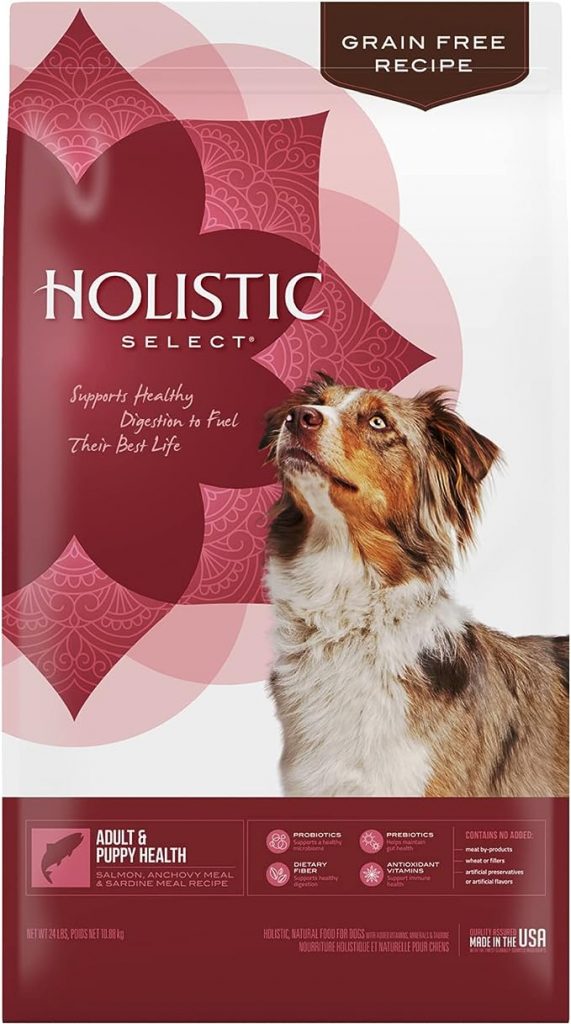
This grain-free option includes multiple protein sources and is suitable for both puppies and adults, making it a convenient choice if you have Blue Heeler puppies and adults at home.
Ingredients: Salmon, anchovy & sardine meal, potatoes, peas, menhaden fish meal.
Pros
- Has plenty of essential amino acids from salmon, anchovies, and sardine meal
- Contains probiotics and prebiotics that help maintain good dog gut health
Cons
- Peas features among the top 3 ingredients
- Expensive
- Does not contain joint-supporting supplements
Recommended Food for Sensitive Blue Healers
8. Instinct raw boost skin& coat health grain-free
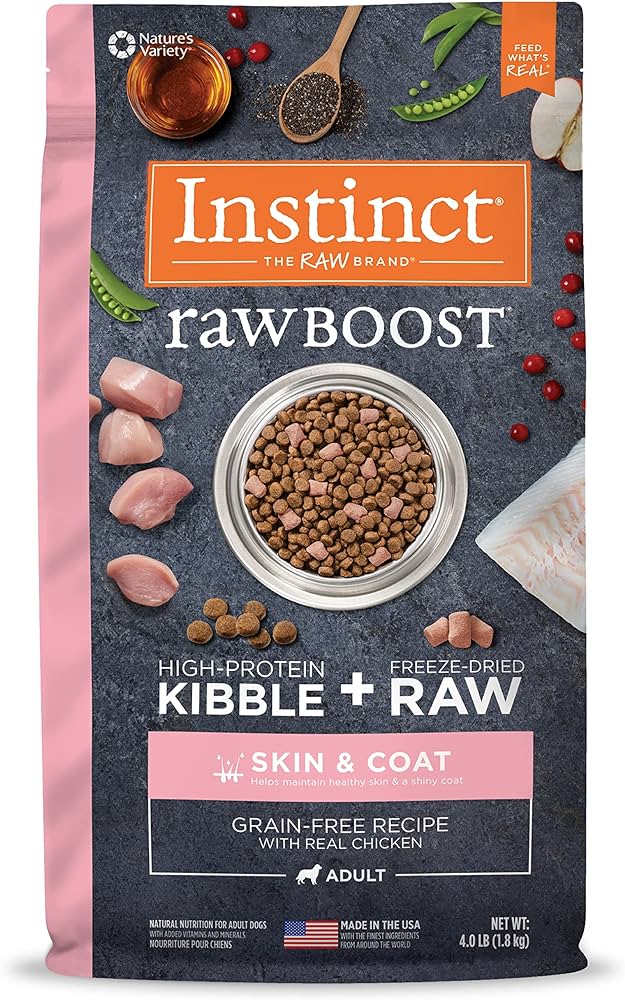
Instinct offers a grain-free option that focuses on skin and coat health. It contains omega-3 and omega-6 fatty acids, which are crucial for Blue Heelers with skin issues.
Ingredients: Beef, peas, menhaden fish meal, herring meal, freeze-dried beef liver.
Pros
- Grain-free
- Contain minerals and vitamins
- No artificial ingredients
Cons
- Lower protein content
- High in salt
9. GO! SENSITIVITIES Limited ingredient venison grain-free dry dog food
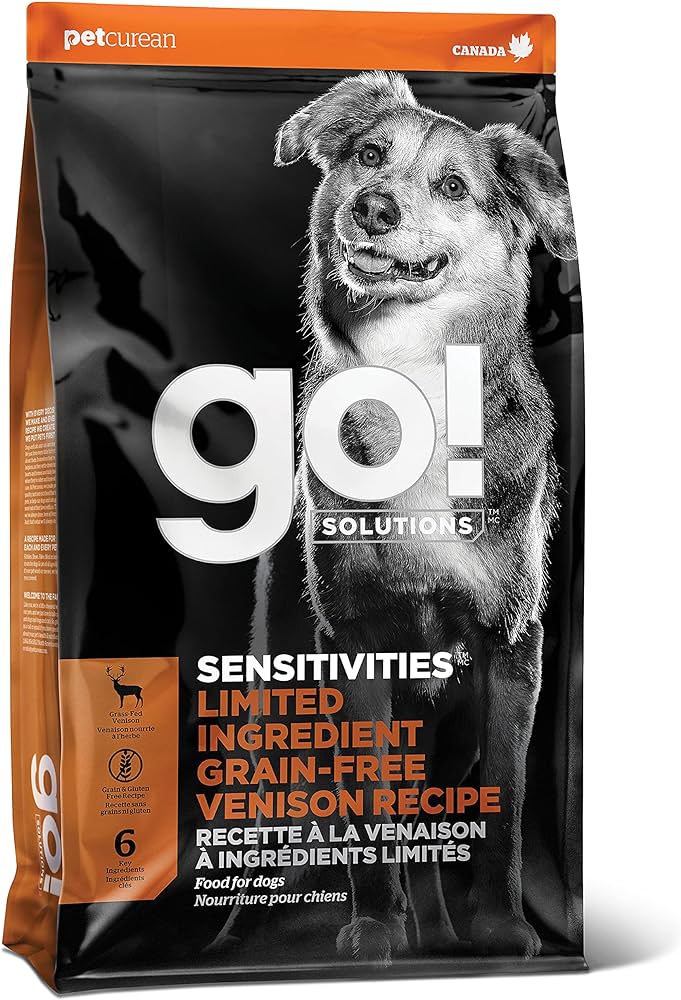
This limited-ingredient formula with venison as the primary protein source is ideal for dogs with food sensitivities. It avoids common allergens and provides a balanced diet.
Ingredients: Venison, peas, lentils, chickpeas, tapioca.
Pros
- Uses venison deer meat as a source of protein
- Uses chicory roots to support digestion
Cons
- Small ingredients list
10. VICTOR Purpose senior healthy weight dry dog food
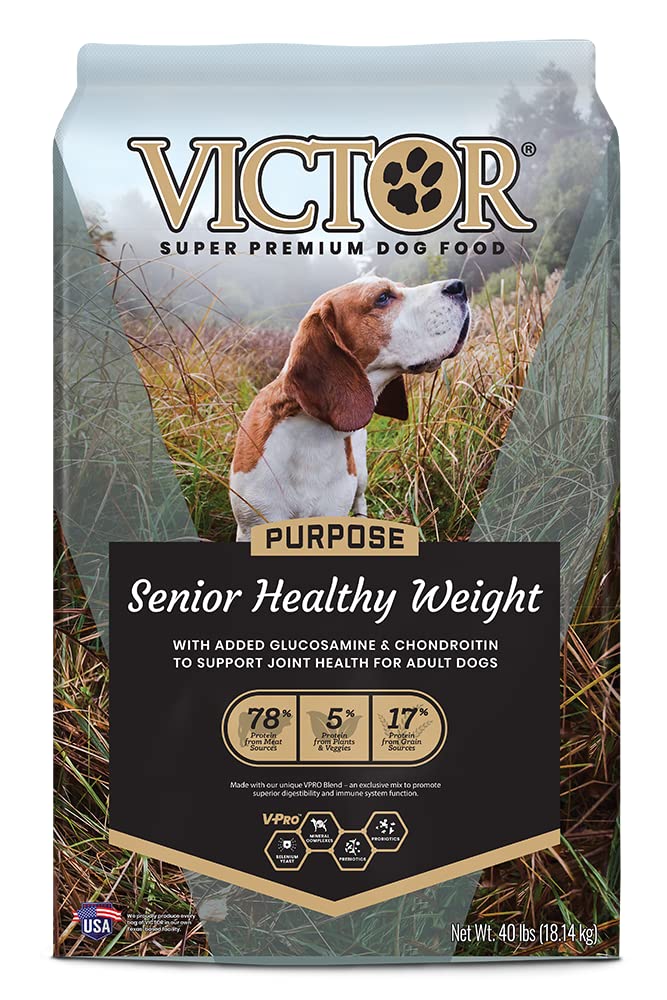
If your senior Blue Heeler needs to manage their weight while staying healthy, this formula is a good choice. It provides the nutrients necessary for aging dogs while helping them maintain a healthy weight.
Ingredients: Beef meal, whole grain brown rice, whole grain millet, grain sorghum, chicken meal.
Pros
- Contains glucosamine that supports aging dog joints
- Contains L-carnitine which aids the metabolism
Cons
- Grains can cause allergies in some dogs
Best Choice for Senior Blue Healers
11. Blue Buffalo Life Protection Formula Senior Chicken & brown rice recipe
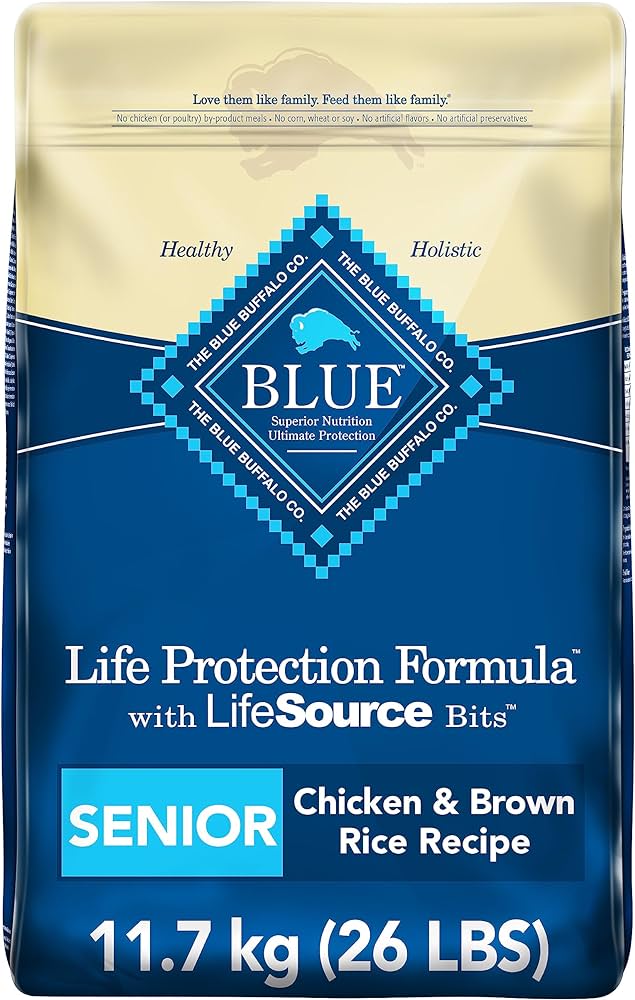
Blue Buffalo’s senior formula focuses on joint health and mobility, making it a suitable option for aging Blue Heelers. It also includes antioxidants for immune system support.
Ingredients: Deboned chicken, brown rice, oatmeal, barley, peas.
Pros
- Blueberries and cranberries are sources of antioxidants used
- Contain omega oils
Cons
- Contains grains that may cause allergic reactions in some dogs
Recommended Wet Canned Dog Food for Blue Healers
12. Instinct original grain-free real beef recipe natural wet canned dog food
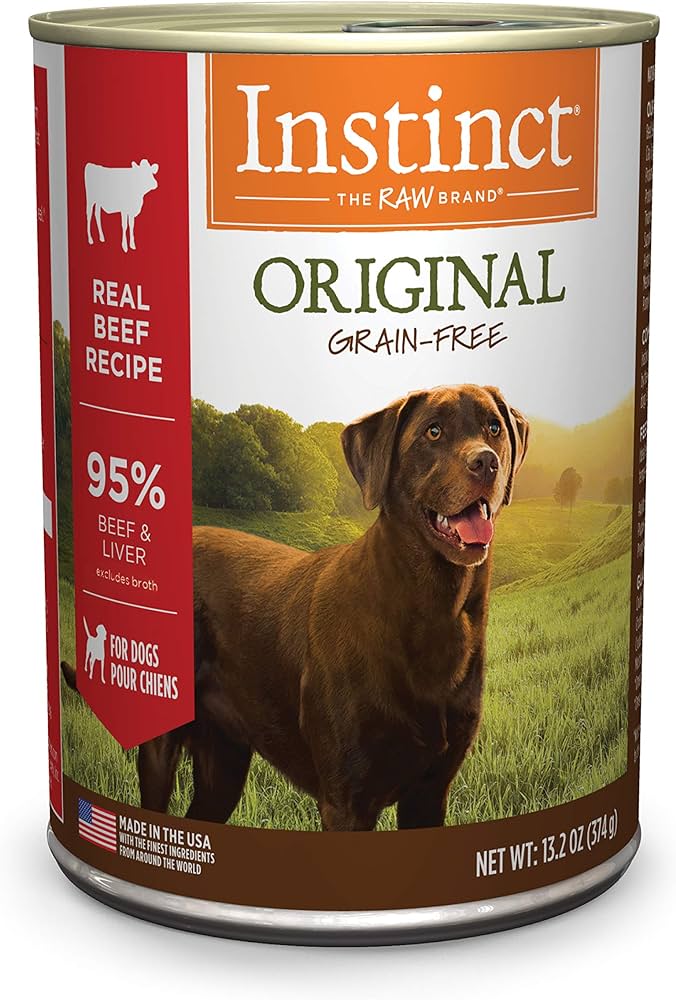
This wet food option contains real beef as the primary protein source. I , preferred this product because its moisture content and grain free nature. Despite being expensive, my blue heeler enjoyed every taste of it.
Ingredients: Beef, beef broth, beef liver, ground flaxseed, montmorillonite clay.
Pros
- Loaf texture
- Visible vegetables
- The main source of protein is beef and liver
- 95% is meat
Cons
- Small ingredients list
- Lower protein content
- High in salt
- costly
Should You Give Your Blue Heeler Dog Dry Kibbles, Wet Food, Raw Diet, Or Homemade?
The choice of whether to feed your Blue Heeler dry kibble, wet food, a raw diet, or homemade food depends on various factors, including your dog’s individual needs, your lifestyle, and your preferences. Many dog owners find success in a combination of these feeding methods, such as mixing dry kibble with wet food or incorporating some homemade or raw components into their diet.
Here are some considerations for each option:
1. Dry Kibble (Commercial Dog Food)
Dry kibble is convenient, cost-effective, and has a longer shelf life. Many high-quality commercial dog foods provide balanced nutrition for Blue Heelers. Kibble helps maintain dental health by reducing plaque buildup. However, some dogs may find dry kibble less palatable than wet food. It can also be less hydrating, so make sure your Blue Heeler has access to fresh water.
Read: Is Kibbles n Bits a Good Dog Food?
2. Wet Food (Canned Dog Food)
Wet food has a higher moisture content, which can help keep your Blue Heeler hydrated. It is often more palatable for picky eaters and can be a good option for dogs with dental issues or those needing a softer diet. Nonetheless, it can be more expensive than dry kibble, and it has a shorter shelf life once opened. Wet food may not provide the same dental benefits as dry kibble.
3. Raw Diet (BARF or Prey Model)
A raw diet may closely mimic a dog’s ancestral diet, and some owners report improved coat condition, energy levels, and fewer food allergies. It can also be tailored to your dog’s specific needs. However, raw diets require careful planning to ensure balanced nutrition and avoid contamination. There’s a risk of bacterial infections, and it can be expensive and time-consuming to prepare.
4. Homemade Food
Homemade diets allow you to have full control over your Blue Heeler’s ingredients, making it easier to accommodate dietary restrictions or allergies. It can be a great option for dogs with specific health needs. Preparing homemade dog food requires research and careful meal planning to ensure it’s nutritionally balanced. It can also be time-consuming and more expensive than commercial options. Consult with a veterinary nutritionist for guidance.
Do Blue Heelers Have Sensitive Stomachs?
Blue Heelers, like many other dog breeds, can vary in terms of their individual sensitivities and digestive health. While they are not known for having inherently sensitive stomachs, some Blue Heelers may be more prone to digestive issues than others due to various factors, including genetics, diet, and environmental factors.
Common Causes For Blue Heeler Stomach Sensitivity
Dietary Sensitivities: Some Blue Heelers may be sensitive or allergic to specific ingredients commonly found in commercial dog foods, such as grains, chicken, or certain fillers. These sensitivities can lead to digestive problems like diarrhea, vomiting, or skin issues. In such cases, switching to a limited-ingredient or hypoallergenic diet may help alleviate these issues.
Environmental Factors: Blue Heelers are active dogs and may ingest non-food items while playing or exploring, which can lead to stomach upset or blockages. It’s essential to monitor their environment and discourage them from eating harmful substances.
Overeating or Rapid Eating: Some Blue Heelers have hearty appetites and may be prone to overeating or eating too quickly. This can lead to indigestion, bloating, or gastric torsion (a severe condition). Feeding them smaller, more frequent meals or using slow-feed bowls can help prevent these issues.
Stress: Like many dogs, Blue Heelers can experience gastrointestinal upset due to stress or anxiety. Changes in routine, travel, or new environments can sometimes lead to digestive problems. Providing a stable and comforting environment can help reduce stress-related digestive issues.
Parasites or Infections: Occasionally, digestive problems in Blue Heelers may be due to underlying issues like parasitic infections or bacterial infections. Regular veterinary check-ups and appropriate deworming and vaccination schedules are crucial to maintaining their digestive health.
It’s essential to be observant and monitor your Blue Heeler’s digestive health. If you notice recurring or severe digestive issues, consult with your veterinarian. They can help identify the cause of the problem and recommend dietary changes, treatments, or interventions as needed. Additionally, working with your vet to select an appropriate, high-quality dog food that aligns with your Blue Heeler’s specific dietary needs can help prevent digestive sensitivities.
What Fruits And Vegetables Can Australian Cattles Dog Eat?
Australian Cattle Dogs, like many other dog breeds, can enjoy a variety of fruits and vegetables as part of a balanced diet. Incorporating these healthy additions can provide essential vitamins, minerals, and fiber. However, it’s important to introduce new foods gradually and in moderation to ensure they don’t upset your dog’s stomach. Here are some safe fruits and vegetables for Australian Cattle Dogs:
Safe Fruits for Australian Cattle Dogs
- Apples: Apples are a great source of vitamins and fiber. Remove the seeds and core before feeding.
- Blueberries: Rich in antioxidants, blueberries are a healthy choice for dogs.
- Strawberries: These berries are low in calories and packed with vitamin C and fiber.
- Bananas: Bananas are a good source of potassium and can be a tasty treat in moderation.
- Watermelon: A hydrating option, watermelon is safe for dogs when seeds and rind are removed.
- Cantaloupe: High in vitamins A and C, cantaloupe can be a refreshing treat.
- Pears: Remove the seeds and core, and offer pears in small, manageable pieces.
Safe Vegetables for Australian Cattle Dogs
- Carrots: Carrots are an excellent source of vitamins and crunch for dental health.
- Green beans: Low in calories and high in fiber, green beans can be a healthy addition to meals.
- Sweet potatoes: Cooked or baked sweet potatoes are rich in vitamins and fiber.
- Peas: Peas are a source of vitamins, and dogs often enjoy their taste and texture.
- Zucchini: Zucchini is low in calories and can be a good addition to meals.
- Cucumbers: A hydrating option, cucumbers can be a refreshing snack.
- Broccoli: Broccoli in small amounts provides vitamins and fiber. Avoid large quantities.
- Pumpkin: Plain, canned pumpkin (not pie filling) is an excellent source of fiber and can aid digestion.
Does Your ACD Need Vitamins and Supplements?
Most Australian Cattle Dogs (ACDs) can obtain all the necessary vitamins and minerals from balanced and high-quality commercial dog food. In general, if you are feeding your ACD a complete and nutritionally balanced diet that is appropriate for their life stage (puppy, adult, senior), you may not need to provide additional vitamin and mineral supplements. Here are some important considerations:
Commercial Dog Food: Choose a reputable commercial dog food that meets the nutritional standards set by organizations like the Association of American Feed Control Officials (AAFCO). These foods are formulated to provide all the essential nutrients your ACD needs.
Life Stage: Ensure that you are feeding your ACD food appropriate for their life stage (e.g., puppy, adult, senior). Each life stage has specific nutritional requirements, and feeding the right formula is crucial.
Variety: Feeding a variety of high-quality dog foods or rotating protein sources within the same brand can help ensure your dog receives a broad spectrum of nutrients.
Consult with Your Veterinarian: Before considering any supplements, consult with your veterinarian. They can assess your ACD’s specific health and dietary needs and recommend supplements if necessary. Adding unnecessary supplements can potentially harm your dog if they receive excessive amounts of certain vitamins and minerals.
Special Health Considerations: Some dogs may require supplements due to specific health conditions, allergies, or deficiencies. Your veterinarian can determine if such supplements are necessary and prescribe them accordingly.
Homemade or Raw Diets: If you feed your ACD a homemade or raw diet, it becomes more critical to work with a veterinary nutritionist to ensure that the diet is nutritionally complete. In such cases, supplements may be recommended to address potential deficiencies.
Giving your ACD excessive amounts of certain vitamins or minerals without proper guidance can lead to health issues. For instance, an excess of certain vitamins like vitamin D can be toxic. Therefore, always consult with your veterinarian before introducing any supplements into your dog’s diet to ensure that you are making informed and safe choices for their health.
How Much Food Does A Blue Heeler Need?
The amount of food a Blue Heeler needs can vary depending on several factors, including their age, size, activity level, and the specific dog food you’re feeding. Here are some general guidelines to help you determine an appropriate portion size for your Blue Heeler:
1. Consider Your Dog’s Age
Puppies: Blue Heeler puppies have higher energy requirements for growth. They should be fed more frequent meals, typically three to four times a day until they are around 6 months old. Follow the specific recommendations on the puppy food label for portion sizes based on your puppy’s age and weight.
Adults: Adult Blue Heelers can typically transition to two meals a day, one in the morning and one in the evening. You can use the feeding guidelines on the adult dog food label as a reference.
Seniors: Senior Blue Heelers may have lower activity levels and may require fewer calories. Adjust the portion sizes based on their activity level and weight management goals.
2. Activity Level
Highly Active: If your Blue Heeler is very active, such as participating in herding activities, agility, or long daily exercise sessions, they may require more calories. In this case, you can feed them slightly more, but monitor their weight to ensure they’re not gaining excess fat.
Moderate Activity: For Blue Heelers with a moderate activity level, standard portion size as recommended on the dog food label should suffice.
3. Monitor Your Dog’s Weight
Pay close attention to your Blue Heeler’s weight and body condition. You should be able to feel their ribs without seeing them. If they start to gain weight, reduce the portion size slightly. If they lose weight or appear too thin, increase it.
4. Treats and Snacks
Be mindful of treats and snacks. They can contribute to weight gain if given excessively. Use them as rewards sparingly, and consider using small pieces of their regular kibble as treats during training.
5. Consult Your Veterinarian
It’s essential to consult with your veterinarian for personalized feeding recommendations based on your Blue Heeler’s age, weight, activity level, and any specific health concerns or dietary needs they may have.
Conclusion
Choosing the best dog food for your Blue Heeler is a vital aspect of responsible pet ownership. Remember that individual dogs may have specific dietary requirements, so it’s essential to monitor their health and adjust their diet as needed. Additionally, always provide access to clean, fresh water, and consult with a veterinarian for personalized nutrition recommendations. With the right diet and care, your Blue Heeler will thrive and continue to be the loyal and energetic companion you adore.

